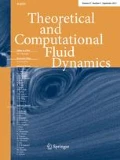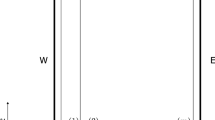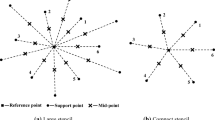Abstract
High-order finite-difference schemes are less dispersive and dissipative but, at the same time, more isotropic than low-order schemes. They are well suited for solving computational acoustics problems. High-order finite-difference equations, however, support extraneous wave solutions which bear no resemblance to the exact solution of the original partial differential equations. These extraneous wave solutions, which invariably degrade the quality of the numerical solutions, are usually generated when solid-wall boundary conditions are imposed. A set of numerical boundary conditions simulating the presence of a solid wall for high-order finite-difference schemes using a minimum number of ghost values is proposed. The effectiveness of the numerical boundary conditions in producing quality solutions is analyzed and demonstrated by comparing the results of direct numerical simulations and exact solutions.
Similar content being viewed by others
References
Anderson, D.A., Tannehill, J.C., and Pletcher, R.H. (1984). Computational Fluid Mechanics and Heat Transfer. McGraw-Hill, Washington.
Bayliss, A., and Turkel, E. (1980). Radiation Boundary Conditions for Wave-Like Equations. Comm. Pure Appl. Math., 33, 707–725.
Bayliss, A., and Turkel, E. (1982). Far Field Boundary Conditions for Compressible Flows. J. Comput. Phys., 48, 182–199.
Briggs, R.J. (1964). Electron-Stream Interaction with Plasmas. MIT Press, Cambridge, MA.
Engquist, B., and Majda, A. (1977). Absorbing Boundary Conditions for the Numerical Simulation of Waves. Math. Comp., 31, 629–651.
Engquist, B., and Majda, A. (1979). Radiation Boundary Conditions for Acoustic and Elastic Wave Calculations. Comm. Pure Appl. Math., 32, 313–357.
Givoli, D. (1991). Non-Reflecting Boundary Conditions. J. Comput. Phys., 94, 1–29.
Jiang, H., and Wong, Y.S. (1990). Absorbing Boundary Conditions for Second-Order Hyperbolic Equations. J. Comput. Phys., 88, 205–231.
Khan, M.M.S., Brown, W.H., and Ahuja, K.K. (1987). Computational Aeroacoustics as Applied to the Diffraction of Sound by Cylindrical Bodies. AIAA J., 25, 949–955.
Oran, E.S., and Boris, J.P. (1987). Numerical Simulation of Reactive Flow. Elsevier, New York.
Tam, C.K.W., and Hu, F.Q. (1989), Three Families of Instability Waves of High Speed Jets. J. Fluid Mech., 201, 447–483.
Tam, C.K.W., and Webb, J.C. (1993). Dispersion-Relation-Preserving Schemes for Computational Acoustics. J. Comput. Phys., 107, 262–281.
Tam, C.K.W., Webb, J.C., and Dong, Z. (1993). A Study of the Short Wave Components in Computational Acoustics. J. Comput. Acoustics, 1, 1–30.
Thompson, K.W. (1990). Time-Dependent Boundary Conditions for Hyperbolic Systems, II. J. Comput. Phys., 89, 439–461.
Author information
Authors and Affiliations
Additional information
Communicated by Jay C. Hardin and M.Y. Hussaini
This work was supported by the NASA Lewis Research Center Grant NAG 3-1267 and in part by the NASA Langley Research Center Grant NAG 1-1479 and the Florida State University through time granted on its Cray-YMP Supercomputer.
Rights and permissions
About this article
Cite this article
Tam, C.K.W., Dong, Z. Wall boundary conditions for high-order finite-difference schemes in computational aeroacoustics. Theoret. Comput. Fluid Dynamics 6, 303–322 (1994). https://doi.org/10.1007/BF00311843
Received:
Accepted:
Issue Date:
DOI: https://doi.org/10.1007/BF00311843




